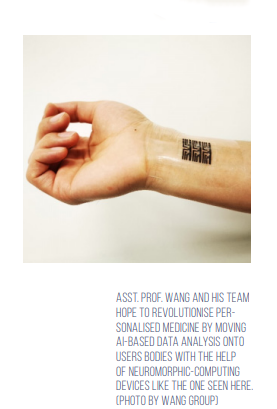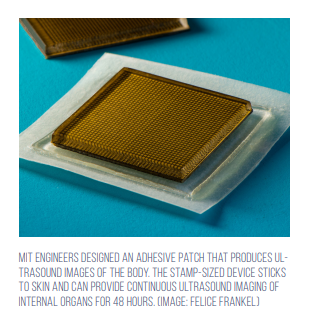Wearable tech – turning us inside out
Technological innovations for the healthcare industry are constantly evolving. Scientists and engineers are always looking for ways to bridge the gap between medical professionals and patients, in a way that will make a positive impact for everyone. Wearable technology is just one of the ways that science fiction is becoming science fact. Electronic Specifier’s Sheryl Miles takes a close look at two of the latest advances in wearable technology.
This article originally appeared in the Oct'22 magazine issue of Electronic Specifier Design – see ES's Magazine Archives for more featured publications.
The first one is a biosensing chip that can predict future diseases, and the second is a small sticker that can see inside the body. And both are set to change the future of healthcare as we know it!
Wearable chip – ordinary vs extraordinary
When the term ‘wearable technology’ is mentioned, smart watches and fitness trackers are usually the first things that come to mind. There are a multitude of them out there. They provide a nice supplement to a healthier way of living, but their purpose is to give you live statistics, or to advise you on what you should be doing to live a better and healthier lifestyle. But they can’t predict the future and they can’t tell you what is actually happening inside your body. And there is a gap between the user and the device, so the wearer always feels it there.
This is something Sihong Wang, Materials Scientist and Assistant Professor of Molecular Engineering from the University of Chicago’s School of Molecular Engineering, said he didn’t want to happen with the small chip he and his team created: “With a smart watch, there’s always a gap. We wanted something that can achieve very intimate contact and accommodate the movement of skin.”
A wearable chip is a biosensor that is encased in a special polymer to mimic the feel of human skin. It is used to draw conclusions just like a human brain. And Wang and his team are using it to process and analyse health data – in real-time.
It is designed to collect data from multiple biosensors. From the gathered data, it then draws conclusions about the health of the wearer.
The idea is that it will not just monitor health, but it will also be able to predict disease – before the wearer even shows symptoms.
The chip is smaller than the palm of a hand, and because of the polymer used it works in tandem with the wearers skin, so the wearer shouldn’t even know they are using it.
The team tested out the theory by analysing ECG (electrocardiogram) data which represented the electrical activity, or heartbeats, of a human heart. The tests were carried out in five ECG categories, ranging from healthy electrical signals through to abnormal signals, and they found that no matter how they manipulated the chip, it still accurately classified the heartbeats.
Because the biosensors can conform to the skin, they can track complex indicators of health-related issues, for example, levels of oxygen, sugar, metabolites, and immune molecules found in the blood.
Much like implantable insulin pumps, it is hoped that the technology will be able to automatically adjust a patient's medication. But more than that, it is also hoped that it could be used to send doctors and patients alerts if something is wrong.
The level of complexity needed for this technology steered the team towards using AI, so they could measure a person’s baseline health measurements and signals indicative of disease – with neuromorphic computing being the most efficient implementation of AI.
It is hoped that in the future, these chips could mitigate the need for a lot of face-to-face appointments.
Wearable sticker
The chip will give a fascinating glance into the future of predicting disease, but what about wearable tech that can actually see inside the body?
Engineers at MIT (Massachusetts Institute of Technology) have designed just that – via a small adhesive sticker.
It is a small patch, measuring 2cm2 x 3mm deep (approximately the size of a postage stamp), and it is made up of two thin layers of elastomer that surround a middle section of solid hydrogel. The bottom layer of elastomer sticks to the skin, and the top layer has a rigid display of transducers that the MIT engineers both designed and fabricated.
It has been designed to see into the body, enabling peoples’ internal organs, such as stomachs, hearts, and lungs to be monitored. The dual concept of the elastomer layer and the rigid top layer allow the device to securely move in tandem with the skin, whilst still projecting clear and precise images.
The wearable sticker will work in a similar way to traditional ultrasound scans, but the MITs hydrogel, unlike traditional ultrasound gels, is elastic and stretchy. The elastomer layers prevent dehydration of the hydrogel that’s needed to transmit images.
Xiaoyu Chen, fellow lead author on the paper published in Science said: “The elastomer prevents dehydration of hydrogel.
“Only when hydrogel is highly hydrated can acoustic waves penetrate effectively and give high-resolution imaging of internal organs.”
The patches were tested by being placed on volunteers’ various body parts, including their necks, chests, stomachs, and arms, whilst they were performing a series of exercises such as sitting, standing, jogging, and cycling. The images were clear and transmitted for up to 48hrs.
The engineers were able to observe major blood vessels as they changed diameter, depending on whether the volunteer was sitting or standing, and they watched as the heart changed shape during exercise.
They were also able to see the stomach swell and then shrink after a volunteer drank juice, and then passed this back out of their system.
Temporary microdamage from weightlifting was also detected.
The sticker can be used in hospitals immediately, and though it doesn’t require hospital staff to constantly use a probe to get an image, it is still reliant on being connected to machinery.
It is hoped that by utilising wireless technology, the patches will communicate directly with mobile phones, allowing AI algorithms to analyse the images on-demand. Once the technology goes wireless and the algorithms are in place, the images will then be better interpreted and diagnosed.
These two technologies are a fascinating breakthrough for the healthcare industry, and they have the potential to change not only the way that patients and medical professionals interact in the future, but also the way we think of wearable technology as a whole.












